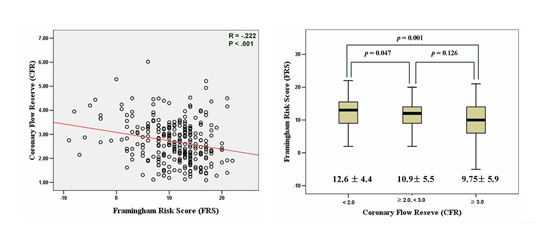| ЙпЧЅЧќНФ : ЦїНКХЭ
|
СЂМіЙјШЃ - 510723 172 |
| Coronary Flow Reserve is Related to 10-Year Risk by Framingham Risk Scores in Subjects with Chest Pain and Normal Coronary Angiogram |
| ъАэЈыІ ыэъЕ ьъГМыэ ьэъИА ыДъГМ |
| ьДыэ, ьЄэИьЄ, ыАьВ ь, ььэ, ьЕьЄь, ыАь э, ьДьЂ
ыЏМ, ьЄььБ, ьЄьЉь, ь ьБьБ, ьЙъИАыАА, ъЙьЌэ, ьЕъЗыГД, эььЁА |
Background and Aim : The syndrome of angina or angina-like chest pain with a normal coronary angiogram, often referred to as syndrome X is an important clinical entity and has usually an excellent prognosis. Although the exact mechanism of this syndrome has not been clearly defined, the decreased coronary flow reserve(CFR) has been suggested as a most important etiology. The aim of this study was to elucidate the relation between CFR and Framingham Risk Score (FRS) in subjects with chest pain and normal coronary angiogram.
Methods : 354 subjects (M:F= 186:168, mean age: 55ТБ11 years) with chest pain and a normal coronary arteriogram were enrolled. CFR using of transthoracic Doppler echocardiography (TTE) and adenosine or dipyridamole was measured within two weeks after coronary angiogram. We compared CFR with FRS .
Results : 1.FRS was 12.6ТБ4.4 in subjects with CFR < 2.0. 2. FRS was 10.9ТБ5.5 in subjects with 2.0тЄCFR<3.0. 3. FRS was 9.75ТБ5.9 in subjects with CFRтЅ3.0. 4.There was a significant difference in FRS between subjects with CFR < 2.0 and CFRтЅ3.0.(p<0.001) 5. CFR had an inverted correlation with FRC (R=-.222, p<.001)(Fig).
Conclusions : Our results suggest CFR is closely related to FRS and the impaired CFR can predict the high 10-year risk of coronary artery disease even in subjects with chest pain and normal coronary angiogram.
|
|
|
Warning: getimagesize(/home/virtual/circulationadmin/htdocs/econgress/conference/abstract/img_files/FRS-CFR.jpg) [function.getimagesize]: failed to open stream: No such file or directory in /home/virtual/circulationadmin/new/econgress/conference/manage/schedule/view_abstract.php on line 164

|
|





